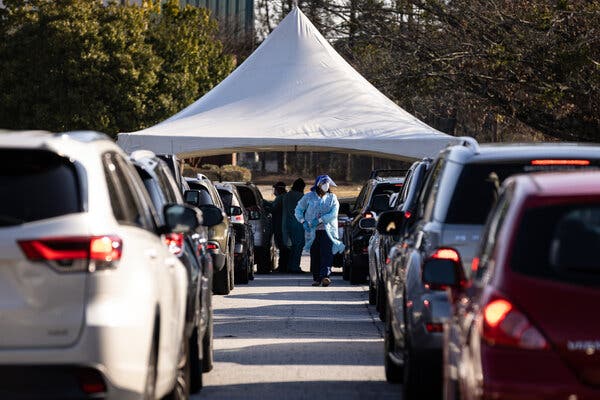
Many Americans have been waiting in long lines at free testing sites since before the Christmas and New Year’s holiday rush. Plenty of others are avoiding the lines and paying $20 or more for over-the-counter, at-home tests — if they can find one.
Out of options, some have headed to crowded emergency rooms .
“The current demand for testing far exceeds the testing resources that are available,” said Michael T. Osterholm, an epidemiologist and director of the Center for Infectious Disease Research and Policy at the University of Minnesota.
That was evident this week as many people searched for tests to take before returning to school or work. President Biden addressed the problem last month by announcing that 500 million tests would be available for free starting in January. But his administration has not given a launch date for the program, and that number of tests will not go far in a country with a population of some 330 million.
Jenna Zitomer, 25, said that her family of five in Westchester, N.Y., has spent around $680 on rapid tests in recent months. “It’s pretty crazy, especially since that’s well over half a paycheck for me,” said Ms. Zitomer, a research specialist. “It feels like something we need to start budgeting for every month now, like groceries or utilities. For my family, not having access to testing could mean exposing multiple severely immunocompromised people to Covid-19. That basically makes it life or death.”
Ms. Zitomer added that at her local testing center, “lines have gotten so long that they started canceling appointments and full days of testing because the drive-through lines cause traffic problems.”
Britt Crow-Miller, 35, a senior lecturer at the University of Massachusetts Amherst, said that her family has spent around $500 on at-home test kits. With two adults and three children, a single round costs around $100. “Who can afford that every time someone has the sniffles?” she said. “As a person fortunate enough to be well-employed and have a partner who is also well-employed, I am very conscious of the fact that at-home testing is essentially a luxury.”
And yet, Ms. Crow-Miller, said that if one of the children “wakes up with a scratchy throat, I don’t feel like a responsible community member sending them to school without first giving them a test.”
Elizabeth Sasser, 24, a network planning analyst living in Syracuse, N.Y., said her expenses for tests — about $300 — was well spent. “My family also did have asymptomatic positives,” she said, “which would have likely led to more infections if it had not been for the prior purchase of at-home tests.”
There have been gaps in testing capacity since the start of the pandemic.
In early 2020, researchers scrambled to find the swabs and liquids needed to collect and store samples being sent to laboratories for polymerase chain reaction, or P.C.R., tests, considered the gold standard for viral detection. U.S. testing backlogs continued into that summer, in part because there was a shortage of tiny pieces of tapered plastic, called pipette tips, that are used to quickly and precisely move liquid between vials.
The equipment shortage is no longer the weak link in the supply chain, but new problems have arisen. One is simply that demand is outstripping supply.
There is also preliminary evidence that the at-home antigen tests many Americans rely on — at least as currently administered, with a nasal swab — may fail to detect some Omicron cases in the first days of infection. Researchers say Omicron replicates faster or earlier in the throat and mouth than in the nose.
That could complicate the strategy for beating back the current wave, in which the latest data from the Centers for Disease Control and Prevention indicate that Omicron accounts for 95 percent of new cases.
The at-home tests, which can deliver results in minutes, remain an important public health tool, scientists say. Positive results are especially informative because it can take days to get results from P.C.R. the tests. But a negative at-home test should be treated with caution.
“Everyone wants these tests to do more than they can,” Dr. Osterholm said.


























